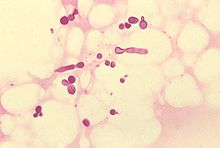SHARES

“We were all stunned. The news came so suddenly. The next thing we realize – his cancer was spreading fast. His final days were painfully miserable. But, he couldn’t make it to his daughter’s wedding.” Greg passed away in his 60’s due to pancreatic cancer.
What is Pancreatic Cancer?
Pancreatic cancer is not common. However, it is one of the top ten causes for cancer deaths. This is because the cancer has almost no symptoms at the early stage, making it very hard to diagnose. Many people are diagnosed at a very late stage in which the chance for treatment is close to impossible. On top of that, pancreatic cancer spreads aggressively. Only a few (~7%) patients survive after 5 years. Therefore, scientists are working very hard to understand this cancer and find ways to detect it in early stages.
New Research Findings on Common Fungus Causing Pancreatic Cancer
Recently, scientists discovered a type of fungus, commonly present on our skin and scalp, has about 3000 fold increase in number in cancerous pancreas. This fungus, called Malassezia spp., normally causes dandruff and skin itchiness (eczema). They are also found in the gut. Previously, some studies are also showing a link between colon and skin cancer with this fungus.
By using fluorescent protein tags, researchers were able to monitor the movement of these fungi in mice guts. They are able to track down the migration of Malassezia spp. from the gut, going through the pancreatic duct to the pancreas. This species of fungi is not part of the native community of fungus (mycobiome) in pancreas. Further research also shows that bacteria as well as other fungi increase manifold in pancreatic cancer along with Malassezia spp. When the cancer is populated by Malassezia spp. alone, it grows at a staggering speed (about 20% faster).
Yet, we still do not know exactly how the fungus causes a normal pancreas to become cancerous. Current studies are looking into how the fungus may alter our body immune system (complement protein cascade) in driving cancerous change in the pancreas.
Possible Cure for Pancreatic Cancer?
Scientists have tried to use medication targeted at these fungus in mice models with pancreatic cancer. The good news is – the cancer stops growing. Then, they further attempt to reintroduce Malassezia spp. to these cancer. Soon, the cancer grows again. These results are confirmed in mice models and further clinical trials on human are needed. Although current research results are promising, the progress to finding a cure for pancreatic cancer is still in its early stage.

“There is one thing that cannot be found when it is lost – Life.” Steve Jobs passed away in 2011 due to pancreatic cancer.
Conclusion
New study findings are pointing towards Malassezia spp., a common fungi in our gut and on our skin, as a potential cause for pancreatic cancer. Although the understanding on the mechanism is not clear, administering anti-fungal drugs do stop the growth of pancreatic cancer in mice models. To confirm the efficacy in the human body, further studies will be necessary.
Find a GP/Family Doctor and Oncologist in Malaysia, on GetDoc
Find a GP/Family Doctor and Oncologist in Singapore, on GetDoc
References
- Berk A, Smruti P, Rounan C, Qianhao L, Raquel A, Jacqueline IK, et al. The fungal mycobiome promotes pancreatic oncogenesis via activation of MBL. Nature. 2019 Oct 2;574:264-67.
- NYU Langone Health. Fungal invasion of pancreas creates cancer risk [Internet]. ScienceDaily.2020. (Available from: https://www.sciencedaily.com/releases/2019/10/191002140317.htm; last updated on 2019 Oct 2; last accessed on 2020 Jan 14)
by Chang Xian
View all articles by Chang Xian.






